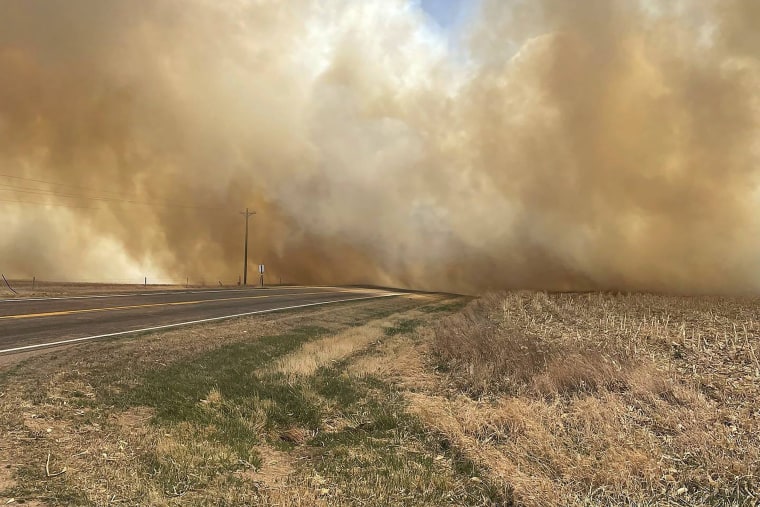An unusually early wildfire season in Nebraska is expected to only intensify through summer as a long-running drought leaves tinder-dry conditions and high winds fan the flames, state officials said.
Firefighters statewide have battled wildfires in at least 14 counties since last week, leaving thousands of acres of land singed throughout central and southwestern Nebraska. The largest of the blazes, the Road 702 fire, has burned more than 41,000 acres since it was first reported on Friday. It is 74 percent contained.
A series of other smaller fires have been extinguished or contained, though officials have not provided an estimate for the total area they’ve burned.
The spate of fires has officials in the state preparing for a long wildfire season ahead.
“Unfortunately, it’s going to take either quite a lot of moisture in a short period of time or consistent moisture over a long period of time to correct it and right now that’s not in our forecast,” said Jonathan Ashford, spokesman for the Rocky Mountain Complex Incident Management team, which is overseeing the response to the Road 702 fire.
The persistent drought conditions that have plagued much of the western United States combined with last year’s dry summer and record-low snowfall in the winter have combined to make grass, bushes and trees in Nebraska more susceptible to catching fire, state officials said. That, along with unusually high winds — blowing 25 miles per hour above the normal average for this time of the year — have led to days of red flag warnings in the state.
A retired fire chief was killed and 15 firefighters were injured fighting the blazes.
Since October, Nebraska has received less than half of the rainfall it typically gets, with the deficit reaching four to six inches where the fires occurred, said Mark Svoboda, director of University of Nebraska-Lincoln’s National Drought Mitigation Center.
“Since we didn’t get that snow, all that grass dried out. Plus, throw in the extra 30 to 50 miles-per-hour winds,” Svoboda said. “Once that’s sparked, there’s nothing you can do to contain that or stop it.”
In Elwood, a village near where the 702 Road fire is blazing, there were 1.20 inches of precipitation last winter, far below the 7.34 inches that normally fall in the area. It was the second driest winter season in 128 years, according to meteorologists in Nebraska.
“A downpour of rain does not help. You need a prolonged wet spring into a wet summer, and you need that probably up to years at this point to really have true recovery in your larger vegetation,” Ashford said.
Another potential challenge for Nebraska in its efforts to battle the blazes is that nearly 90 percent of the state’s 1,5419 firefighters are volunteers who often leave work or home abruptly to respond to the emergencies.
The result sometimes led to slower response times in remote areas, Ashford said, allowing fires to grow and overworking crews.
“That is one of the challenges,” Ashford said. “When you have things happen in more rural environments where you’re relying on those volunteers, there is a time frame that it takes to get those folks to respond. And it also means we probably have a somewhat limited number of people who are available in an immediate area at any given time.”
But Jerry Thompson, president of the Nebraska State Volunteer Firefighters Association, said that hasn’t put his members at a disadvantage, adding that their efforts have been bolstered by aid from neighboring states.
Meanwhile, a single-engine plane that was expected to be deployed this summer to drop foam on fires to prevent them from growing is being delivered early in the next few days to assist in the effort, said Jodie Fawl, spokeswoman for the Nebraska Emergency Management Agency.
“If we can get the fires stopped and contained early, that’s a good way to prevent the fires from getting out of hand,” she said.
Emergency officials also said cutting down trees in the western and northern part of the state where wildfires are more prevalent is another option.
The fire in Nebraska is one of 11 large wildfires reported across the U.S. so far this year.
Four of them were reported on Monday, two in Colorado and one each in Oklahoma and Virginia, according to the National Interagency Fire Center.
In addition, a fast-moving fire covered more than 4,000 acres of land in New Mexico earlier this month in part because of warming temperatures.
